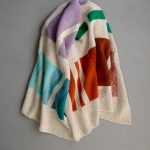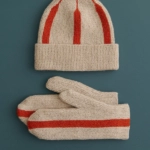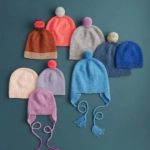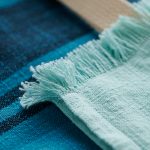Striped Cotton Cowl

Spring is here on our calendars, but it sure doesn’t feel like it here in New York! Everyone is still walking around bundled up in… you guessed it, cowls! They were the word on the street this winter when we brought you the Big Herringbone Cowl, and as we move into spring, cowls are here to stay, now in cool cottons and spring colors. It’s really no wonder we love the cowl: no questions of wrapping or tying, no loose ends dragging through mud puddles and no getting caught in subway doors! I’m sold!

And so for spring, I decided to make a cuddly soft cotton cowl because April is no picnic! For the main yarn we chose Blue Sky’s superlatively cozy Worsted Cotton in the subtle color Drift, a pale, pale gray, almost white. To it we added Olympus’s Sashiko Thread in bright, beachy stripes. The simple matte cotton of the Sashiko Thread and the casually natural Worsted Cotton conspire to make a no-fuss cowl with a whole lot of style. A little off kilter, a little rustic and a lot charming!

Designed by Purl Soho designer, Whitney Van Nes.
Share your progress and connect with the community by tagging your pics with #PurlSoho, #PurlSohoBusyHands, and #PurlSohoCtripedCottonCowl. We can’t wait to see what you make!
Materials
- Main Yarn: 3 skeins of Blue Sky’s Worsted Cotton, 100% Cotton. This color is Drift. Approximately 450 yards required.
- Olympus’s Sashiko Thread, 40 meters, 100% Cotton. I used 3 skeins of Off White; 2 skeins of each of the following colors: Carrot Orange, Yellow, Gold and Aqua; and 1 skein of Red and of Navy. (If you’d like to design your own stripes, it will be helpful to know that the whole cowl uses 400 yards of yarn and each skein of Sashiko Thread is 44 yards, so at minimum you’ll need 9 or 10 skeins.)
You’ll also need…
- US 10 (6 mm), straight or circular needles
- A tapestry needle
Gauge
17 stitches = 4 inches in garter stitch, holding a strand of Main Yarn and Sashiko Thread together
Size
Finished Dimensions: 60 inches around and 8½ inches wide
Notes
- When this pattern refers to “ridges”, it means a garter stitch ridge which is formed by knitting two rows. Counting “ridges” is an easy way to determine how many rows you have knitted without having to count as you work. If you find this confusing, just multiply the number of ridges given by 2 and that is how many rows you should knit (ie 3 1/2 ridges is 7 rows).
- You will always be knitting with one strand of the Blue Sky Cotton, called the Main Yarn (MY), and one strand of Sashiko Thread. It’s easy! Just pull a strand from each of the two balls. Don’t worry about anything except making sure you get your needle under both strands as you knit.
- To avoid an overwhelming number of ends to weave in, I knit some of the ends in as I worked. Just hold the tail(s) with the working yarns and knit it along for four or five stitches. Hardly noticeable and very time saving!
Pattern
Begin
With the Main Yarn (MY) and the Off White Sashiko Thread, use a Provisional Cast On to cast on 36 stitches. (Why a provisional cast on? So that at the end of the project you can graft the cast on and cast off ends together, avoiding a seam. However, if you find a provisional cast on a bit overwhelming, then just cast on normally, and when you’re finished you can sew the two ends together. Your cowl will still be beautiful!)
Knit 3 ridges. Cut the Off White Thread.
With the MY and the Orange, knit 15½ ridges. Cut the Orange Thread.
With the MY and the Yellow, knit 7 ridges.
You will continue in this pattern, cutting the old Thread at the end of each section and adding the new Thread at the beginning of the next section. Here is how the stripe sequence continues:
- 2½ ridges with Navy.
- 11 ridges with Off White.
- 1½ ridges with Red.
- 6 ridges with Off White.
- 3½ ridges with Aqua.
- 2 ridges with Orange.
- 8½ ridges with Aqua.
- 12 ridges with Gold.
- 5½ ridges with Yellow.
- 4 ridges with Off White.
- 2½ ridges with Red.
- 4 ridges with Orange.
- 12½ ridges with Off White.
- 6 ridges with Aqua.
- 2½ ridges with Navy.
- 4 ridges with Gold.
- 1½ ridges with Aqua.
- 15 ridges with Yellow.
- 3½ ridges with Red.
- 3 ridges with Off White.
- 6½ ridges with Orange.
- 2 ridges with Off White.
- 13½ ridges with Gold.
- 4 ridges with Aqua.
- 1½ ridges with Red.
- 3 ridges with Gold.
- 4½ ridges with Off White.
- 9 ridges with Yellow.
- 4½ ridges with Navy.
- 14 ridges with Aqua.
- 1½ ridges with Off White.
Cut both yarns, leaving a tail approximately 36 inches long.
Preparing to Graft
Bring the ends of the cowl around to meet each other, making VERY sure that there are no twists in the fabric (unless, of course, you intentionally want one!).
Pick up the 36 stitches of the Provisional Cast On (check our tutorial for how-to’s), making sure, if you’re using straight needles, that the ends of your needles are pointing the same way. If you’re using circular needles, you’ll need to ensure that the tail is situated at one end, not caught in the middle of your needles.

For the grafting to be seamless you need one end of the cowl to have ended on a purl row and the other end to have ended on a knit row. Look closely at the rows closest to your needles and double check that this is the case. If it’s not, then take out the last row you knit, and reorient your stitches on the needle so the tail is still at the end.
Here’s how ending with a purl row looks (see how the purl bumps are snug up against the needle?):

And here’s how ending with a knit row looks (see how the last row looks like little “v’s”, aka knit stitches?):

Now thread the tail onto a tapestry needle and you’re ready to begin the Kitchener Stitch.
Kitchener Stitch
NOTE: For a detailed Kitchener Stitch tutorial, click here. It’s important to know that our tutorial shows how to graft two pieces of stockinette together, while here we’re grafting together two pieces of garter stitch. So the order of our steps will be slightly different than the tutorial’s, but you may still find it very helpful.
The first two steps of Kitchener Stitch are set up steps and only happen once at the beginning. Holding the two knitting needles parallel to each other, thread the yarn through the first stitch of the FRONT needle (the needle closer to you) as if to PURL and LEAVE the stitch on the needle.
Next, thread the yarn through the first stitch of the BACK needle as if to PURL and LEAVE it on the needle.
That completes the set up. Continue…
Step 1: Thread the yarn through the first stitch of the FRONT needle as if to KNIT. REMOVE the stitch from the needle.
Step 2: Thread the yarn through the next stitch on the FRONT needle as if to PURL. LEAVE it on the needle.
Step 3: Thread the yarn through the first stitch on the BACK needle as if to KNIT. REMOVE it from the needle.
Step 4: Thread the yarn through the next stitch on the BACK needle as if to PURL. LEAVE it on the needle.
Repeat Steps 1 through 4 until two stitches remain, then KNIT the FRONT stitch and REMOVE it and KNIT the BACK stitch and REMOVE it.
A LITTLE TIP: After years of messy grafting, I’ve finally learned that holding my index finger between the knitting needles creates good tension and a neat finish! Like this:

Now all that’s left to do is to weave in any ends you have left and to enjoy on your new Striped Cotton Cowl!





Is the orange you used Sashiko Carrot Orange 04? Also, there isn't a white in stock of the Sashiko. Can you recommend a white in the DMC? Thanks!
Hi Im,
Yes, the orange is Carrot Orange. I've changed the materials list to accurately say that (Sashiko added a new orange since this project was posted and changed some names around, so thank you for straightening us out!).
By the way, you can get all of the yarn together in one place with Purl Soho's Yarn for Striped Cotton Cowl kit. You can find it right here: https://www.purlsoho.com/purl/products/item/9120-Purl-Soho-Yarn-for-Striped-Cotton-Cowl .
Or if you'd like to assemble your own colors, you can either contact our web site to find out when the Off-White Sashiko Thread will be back in stock (https://www.purlsoho.com/purl/contact), or use DMC's #3866 (https://www.purlsoho.com/purl/products/item/8232-DMC-Embroidery-Floss).
Please let us know if you have any other questions and thank again for cluing us into the orange discrepancy!
Whitney
I love my cowl. Now after quite a lot of wear it needs to be washed.
I am concerned that the Sashiko thread will bleed into the Blue Sky yarn when washed. Will it? Any suggestions on the best manner of cleaning?
Hi Steff,
We have never heard reports of the Sashiko Thread bleeding. I'd recommend hand washing your cowl in a gentle detergent, rinsing it, squeezing it, and laying it out flat to dry. It should be fine!
Thanks for asking and I'm so glad your cowl gets a lot of love!
Whitney
Hello,
I cannot wait to knit this and have my BSA cotton in my cart. However, I was wondering if you could recommend a multi-colored or variegated thread/ yarn to carry along so that I would not have to cut/reattach so many different threads. I travel/fly a lot and this would greatly increase the conscience if this project. Thanks so much! I love the Purl Bee <3
HI Megan,
Great idea! I would definitely use Koigu's Painter's Palette Premium Merino (https://www.purlsoho.com/purl/products/item/409-Koigu-Wool-Designs-Koigu-Painters-Palette-Premium-Merino-KPPPM). There are spectacular colorways to choose from and it's just a beautiful yarn. Although KPPPM is a fingering weight, it's a bit thicker than the Sashiko Thread, so you may need to go up a needle size. Experiment a little!
Thanks for the question and please let us know if you have any more!
Whitney
I purchased some DMC embroidery floss to use for this project and I'm wondering if I should separate the strands. Using it as is seems like it might be a little thick.
Hi Katie,
I think the DMC seems about the same thickness as the Sashiko Thread, but I'd recommend testing it out! Consider if you like both the density of the fabric and the proportion of floss to yarn. Your experimentation may also require that you try different needles sizes. For example, if you like how the DMC looks with 6 strands but not how it feels, then you may need to change the needle size.
I hope this puts you on the right path! Please let us know if you have any more questions and thank you so much for this one!
Whitney
Just wanted to update: I didn't end up separating the DMC floss and am knitting this with Cascade 220. I'm over 1/2 way done, and it's coming out lovely. This is the perfect striped cowl. Beautiful colors without being too overwhelmingly "rainbow".
For the cascade yarn are you using a 6mm?
And what colour did you use
Hi There,
I really love! this cowl pattern–the yarn, thread, and colours you chose are just beautiful. The only issue: I don’t knit, and this does pose a problem at the present time. I’m hoping you can help me to loosely transfer this to a crochet project with a nice ridged stitch pattern like the knitted version. I realize that the thickness and fluidity/draping of the scarf will be compromised, but I love the rustic look of the various colours of thread stitched together with the clean “background” stitch in one consistent colour. Thanks for taking your time to suggest something until I finally learn how to knit and expand my creative boundaries!
Hi Lisa Rose-
We don’t have a crocheted version of this particular cowl but you might consider using our Crocheted Rib Cowl pattern as a jumping off point: https://www.purlsoho.com/create/2013/09/19/whits-knits-crocheted-rib-cowl/ Perhaps you could use the ribbed crochet stitch with these materials?
Thanks for getting in touch!
Molly
I just received my kit in the mail, but I can’t seem to get started. How can I knit at a smooth pace without the Sashiko thread knotting up? Any tips on how to handle these pull skeins? I’m having a really, really hard time with them.
Thanks,
Kristin
Hi Kristen-
Before you get started you need to roll all of your yarn and the sashiko thread into balls. Each separate skein will be rolled into it’s own ball, you don’t need to roll them together. I found this helpful tutorial from another site about how to roll a skein into a ball, and you can find many more if you google it! http://notsogranny.com/2014/03/how-to-wind-a-ball-from-a-skein.html
I really hope this solves your problem. If not, please let us know!
Best-
Molly
What a nightmare! The Sashiko thread is a bear to work with. Finally after hours of tangling, I figured out that the best way to work with it is to wrap it around small pieces of cardboard (which took hours). A project which should have been so quick and simple has taken weeks and weeks because of this. Warning to all who attempt. What a pain.
Hi Kim-
I am so sorry to hear that you had problems with this! The Sashiko thread comes in hanks and all yarn that comes in hanks needs to be wound into a ball before you can knit with it. Please see my response above to Kristen for more info about how to wind it into a ball. And please let us know if you have any more questions or concerns about this project.
Once again I am so sorry this project hasn’t been enjoyable for you. If you aren’t done with the project yet, winding the Sashiko thread into balls will make the remainder go much faster!
Thank you for getting in touch!
Best-
Molly
I’ve loved this pattern since you first published it. I thought that there was some reference to a baby blanket pattern in the original dialogue about this cowl. Can you give me some guidance in converting this pattern?
Hi Gail!
The good news is that this is just garter stitch! It doesn’t matter what multiple of stitches you use – just cast-on the number you need for the width of blanket you’d like. I’d also suggest getting 2-4 times as much yarn and thread depending on how large you’d like the baby blanket.
Happy Knitting!
Thomas
I am finally ready to make this pattern into a baby blanket. I want to use red, pink, yellow, yellow green and aqua. I’m planning to do it in a color block , using all of a skein of the cotton for each color. (I’ve knitted the chevron baby blanket like that, and loved the effect of the color block)
Help me decide on which colors to use, and suggest some others to compliment those, for a total of 7 colors. Also, recommend a color for the cotton that will go best with the colors chosen.
I loved your suggestions for my chevron blanket, and want your eyes on this project too!
Thanks, Gail
Hi Gail,
Thanks for writing in and apologies for the delayed response! I would suggest using the Blue Sky Worsted Cotton in the color Drift for your base color. It is a lovely neutral that will feature the Sashiko thread in a pleasing way. In additional to the colors that you selected, I would add either Orange and Royal Blue for a rainbow or Purple and Ultramarine for a bit of contrast. You could also substitute one of the colors for a white to create the bit of blank space for each color that is so pleasing in this cowl!
I hope that this helps!
Cassy
Just finished the cowel. Used DK baby “softee” and DMC. Turned out great, soft and great, and goes with everything.
Hi. I would love to make this cowl in all one color. I have 3 skeins of light pink cotton from blue sky alpaca. Do I need an additional skein? Do I just follow the pattern at the beginning section (where I cast on 36 stitches) and just knit until I get 60 inches in length? Thanks for your help!
Hello Katiusca,
Yes, it sounds like you have the same yarn that the pattern used and that you understand the construction very well! Not including the embroidery floss would change the gauge slightly, so you may want to do a little swatch and then adjust the needle size if necessary.
Best of luck! -Alyson
I just ordered the Striped Cotton Cowl kit. Soooo looking forward to starting it! Thanks for making these kits available to us!! — Steve R.
Questions about this beautiful cowl-What length circular needles do you recommend using?
In the picture of the yarns used , the Sashiko thread skeins look like from left to right-red, gold, yellow, green, white, aqua and navy. But the pattern doesn’t call for green? And I don’t see an orange in the picture?
Hi, Laura!
Thank you for writing in! You can use either a 16-inch or 24-inch circular needle for this cowl. The Sashiko thread colors that we used are Carrot Orange, Yellow, Gold, Aqua, Red and Navy. The Orange is in there, but it is a bit difficult to distinguish the Orange from the Yellow in the photo. If you take a look at the pattern you can see where we used the Orange:
“2 1/2 ridges with Navy.
11 ridges with Off White.
1 1/2 ridges with Red.
6 ridges with Off White.
3 1/2 ridges with Aqua.
2 ridges with Orange.
8 1/2 ridges with Aqua.
12 ridges with Gold.
5 1/2 ridges with Yellow.
4 ridges with Off White.
2 1/2 ridges with Red.
4 ridges with Orange.
12 1/2 ridges with Off White.
6 ridges with Aqua.
2 1/2 ridges with Navy.
4 ridges with Gold.
1 1/2 ridges with Aqua.
15 ridges with Yellow.
3 1/2 ridges with Red.
3 ridges with Off White.
6 1/2 ridges with Orange.
2 ridges with Off White.
13 1/2 ridges with Gold.
4 ridges with Aqua.
1 1/2 ridges with Red.
3 ridges with Gold.
4 1/2 ridges with Off White.
9 ridges with Yellow.
4 1/2 ridges with Navy.
14 ridges with Aqua.
1 1/2 ridges with Off White.”
If you have further questions please let us know. Again, thank you for writing in!
Best wishes,
Kumeko
Hi love this scarf. I have a question regarding the last picture where we see your fingers between the needles and I realized that they both appear to have ended on the knit row because we see the purl stitch on both needles back to back.. Am I right or is there a mistake?
Hi Doreen,
That’s an interesting question! The answer lies in the fact that one needle is showing the right side of the work (the front needle), and one needle is showing the wrong side of the work (the back needle). So, because the back needle is showing purl stitches on the wrong side, it was actually worked as a knit row!
I hope that makes sense… Please let us know if you have any other questions and thanks so much for this one!
Whitney
Hello,
I’ve been wanting to make this cowl for years! I’m finally going to do it! I noticed the kit isn’t sold anymore and Blue Sky has discontinued the worsted cotton.. Could you please give some other similar yarn options (even if the gauge needs to be adjusted) with something close to the drift color? Do you think wool or other fibers would have the same effect? Thanks so much!
Liza
Hi Liza,
Thanks for your interest in this pattern! Glad you’re finally getting around to making it! The yarn is actually still available and we do sell it. Click here for the Blue Sky Worsted Cotton. Best of luck!
-Adam
I was wondering if I can knit this in one color? Well, actually the yarn I am thinking of is multi colored ..in the yarn. It’s worsted cotton.
Thank you.
Hi Barbara,
Thanks for writing in! You can definitely knit this in one color. Just ignore the directions to switch colors and you should be fine. Thanks!
-Adam
Hi, I’m a beginner knitter & are going to attempt this one. I can see that you have smaller bundles of thread available so I’ll double the amount to purchase but I can’t see any of the off white colour on white. I think this will make a distinctive difference in the pictured sample. Any ideas? Or do you think it will look ok?
Hi Tammy,
Thanks for writing in! The off white does tend to blend into the cotton yarn! We do recommend that you use it though as if you do not use it, the sections that are white will be a bit thinner and the gauge will be a bit off. The biggest way that you may see this is that the edges in those sections may squeeze in a little bit. To get a consistent width, we would suggest using the off white!
Best,
Cassy
Would love to make this and I see the Blue Sky is available but not the Sashiko. Any suggested alternatives?
Thank you!
Hi Crystal,
Thanks for reaching out! We do still carry Olympus Sashiko Thread – I apologize that our link above was out of date! I have now corrected it, and you can also see our selection of sashiko thread by clicking here!
Best,
Julianna